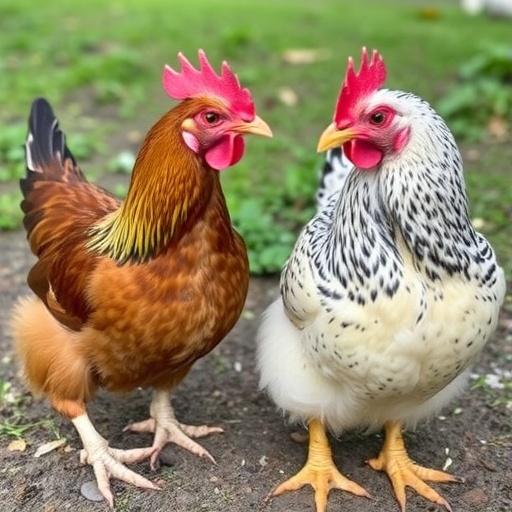In a groundbreaking study, researchers have delved into the seroprevalence of infectious bursal disease (IBD) in backyard chickens in Wag-Lasta, Amhara, Ethiopia. This extensive investigation not only identifies the presence of IBD among these birds but also highlights significant co-infections, specifically with Newcastle disease (ND) and Salmonellosis. The findings shed light on the pressing health challenges faced by poultry farming in this region and the potential implications for the livelihoods of local farmers.
Poultry is an essential component of the Ethiopian agricultural landscape, providing critical food resources and economic opportunities for many households. However, infectious diseases pose a significant threat to the health of these birds, subsequently endangering the food security and income of farmers. The study by Bahiru, Tibebu, and Yitbarek offers valuable insights into the prevalence of these diseases within a specific geographic context, illustrating the complex interplay between various pathogens in backyard chickens.
Infectious bursal disease, caused by the IBD virus, primarily affects young chickens, leading to immunosuppression and increased susceptibility to other infections. The researchers noted that the implications of IBD extend beyond individual birds; outbreaks can devastate entire flocks, causing severe economic losses for farmers. The data collected emphasize the need for vigilance and proactive management practices among poultry farmers to combat this infectious threat.
Newcastle disease, another viral infection, further complicates the landscape of poultry health in the region. Characterized by respiratory distress, neurological signs, and high mortality rates, ND remains one of the most significant avian viral diseases worldwide. The co-occurrence of ND with IBD creates a perfect storm for the health of chickens, dramatically increasing the likelihood of disease transmission and negative outcomes. The researchers’ findings regarding the co-infection rates underline the urgent need for integrated disease management strategies.
Salmonellosis introduces another layer of complexity to the health status of backyard chickens in Wag-Lasta. This bacterial infection, often linked to unsanitary conditions and poor management practices, can affect poultry and pose public health risks through the contaminated meat and eggs. The team’s investigation into the prevalence of Salmonella among chickens reveals critical risk factors associated with its transmission, such as environmental conditions, housing practices, and the health status of birds.
The research highlights the interrelationships among these diseases and underscores the importance of comprehensive surveillance efforts. Understanding how IBD, ND, and Salmonellosis co-occur is vital for developing effective control measures to safeguard poultry health and, by extension, the economic stability of smallholder farmers in the area. The study emphasizes that disease management in backyard chickens cannot be viewed in isolation; rather, it necessitates a holistic approach considering the myriad interactions among different pathogens.
One of the key findings of the research pertains to the risk factors associated with the seroprevalence of these diseases. The researchers identified specific practices within backyard farming that could contribute to increased vulnerability. For instance, inadequate biosecurity measures, such as unrestricted access to wild birds, poor sanitation practices, and limited vaccination protocols, play a pivotal role in disease prevalence. Such insights are critical for stakeholders involved in poultry health strategies, as they can help shape educational programs and intervention methods.
The local climate and environmental challenges also emerge as significant elements affecting disease dynamics. Fluctuating temperatures and the prevalence of certain pathogens may correlate with the seasonal health of backyard chicken populations. The researchers’ careful analysis of these environmental factors can aid farmers in implementing seasonal management practices to mitigate disease risks.
Beyond the immediate health implications for backyard chickens, the study serves as a reminder of the broader context of food security in Ethiopia. Given that poultry farming is often the primary source of protein for many households, understanding the health of chickens has ripple effects on overall nutritional health. The economic implications of poultry disease outbreaks can be profound, leading to increased prices for poultry products and reduced availability for communities reliant on these resources.
As the study builds on previous research, it contributes to a growing body of literature that highlights the need for ongoing veterinary education and intervention strategies in rural areas. By combining local knowledge and advanced scientific approaches, stakeholders can develop tailored interventions to enhance the resilience of poultry farming against infectious diseases.
Furthermore, the research underscores the necessity for collaborative efforts between various sectors, including veterinary services, agricultural extension workers, and household farmers. Integrated approaches will be crucial to ensure that resources are shared effectively and that education around disease prevention and treatment is both accessible and practical for local farmers.
In conclusion, the seroprevalence study conducted by Bahiru and colleagues is a pivotal contribution to our understanding of poultry health in Ethiopia. By shining a light on the interconnected threats posed by IBD, ND, and Salmonellosis, the findings advocate for a unified approach to disease management that embraces local farming practices while incorporating scientific rigor. As researchers continue to explore these complex relationships, farmers stand to benefit immensely through improved health outcomes and economic stability.
The dynamics of disease prevalence in backyard chickens are not just a veterinary concern; they encapsulate broader socio-economic themes that impact communities deeply. Through continued research and proactive management, the hope for healthier poultry populations and more prosperous communities in Ethiopia can become a reality.
Subject of Research: Seroprevalence of infectious bursal disease, co-infection with Newcastle disease and salmonellosis in backyard chickens.
Article Title: Seroprevalence of infectious bursal disease, co‑infection with Newcastle disease and salmonellosis and the associated risk factors in backyard chickens, Wag‑Lasta, Amhara, Ethiopia.
Article References:
Bahiru, A., Tibebu, A., Yitbarek, T. et al. Seroprevalence of infectious bursal disease, co ‑infection with Newcastle disease and salmonellosis and the associated risk factors in backyard chickens, Wag‑Lasta, Amhara, Ethiopia.
Discov Anim 2, 83 (2025). https://doi.org/10.1007/s44338-025-00137-z
Image Credits: AI Generated
DOI: 10.1007/s44338-025-00137-z
Keywords: Infectious bursal disease, Newcastle disease, Salmonellosis, seroprevalence, backyard chickens, Ethiopia.




